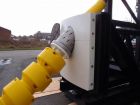
New cable connectors for offshore monopiles at EWEA 2015
First Subsea announces new connector systems that revolutionise the speed of installation and engineering integrity of power cable connections to offshore wind turbine monopiles, at EWEA Offshore 2015. The Monopile Interface Connector (MIC) and Hang-Off Connector (HOC) provide quicker, simpler, less manpower intensive, and thus safer cable connections offshore.
As the offshore wind industry grapples with the high cost of turbine deployment, cable installation is an area where significant savings can be made. The Monopile Interface Connector provides a complete cable protection system (CPS), comprising connector and bend stiffener. Using ball and taper gripping technology allows a J-tubeless cable connection to the monopile from any installation angle. The connector provides an automatic and powerful multi-point connection to the monopile wall.
The MIC cable protection system is engineered to optimise fatigue resistance and wear on the cable. Assembly can be completed either at the cable manufacturers onshore or offshore on the installation vessel. It is then deployed from the cable laying vessel, and pulled in using the monopile’s winch, enabling a diverless cable installation. Once connected, the cable is pulled through the CPS to the hang off deck for termination.
Hang-Off connector cable installation
The First Subsea Hang-Off Connector (HOC) allows a quicker installation of pre-stripped cable through an instantaneous structural connection to the monopile’s internal hang-off deck. The HOC is pre-installed onto the cable onshore, and the cable pre-stripped under factory controlled conditions, rather than offshore on the monopile. In addition, the cores are cut to length ready to connect into the distribution board, effectively taking this element of cable preparation off the offshore critical path. And, with fewer people now needed to work on the monopile, it also significantly reduces the health and safety risk of cable installation by cutting the number of crew transferred from one vessel to another and from vessel to monopile.
“Either used separately or together the Monopile Interface and Hang-Off Connectors offer substantial time and cost saving benefits over other systems in the market,” says John Shaw, managing director, First Subsea Ltd. “We have had substantial interest in both systems and look forward to developing these opportunities over the coming months.”
Avoiding Costly Disconnections
In the event of damage to the cable, or perhaps a cable failure, it will need to be replaced. Experience has shown that current cable connectors are difficult to disconnect. The First Subsea MIC and HOC connectors avoid these problems. They have been designed from the outset for ease of latching and delatching, should the need arise, for recovery of the cable.
‘Lean’ Cable Installation Methodology
The ease of connection and disconnection of the First Subsea cable connector is consistent with the company’s Lean Installation approach to subsea connections. Using Lean Installation principles, the MIC and HOC cable connectors has been developed to reduce waste through quicker connection and disconnection and improve the engineering integrity of the cable installation. In effect, transforming offshore wind cable installation to make it quicker, simpler and more cost-effective compared with other connection systems.
For more information on First Subsea’s MIC and HOC connectors for offshore fwind energy projects call First Subsea on +44 (0)1524 387777, email: renewables@firstsubsea.com and visit www.firstsubsea.com.
Released: 10th March 2015


